
|
|||
|---|---|---|---|
|
|
Modern games and competitions of peoples of Russia. "Northern Multiathlon": a condition, problems, prospects of development |
|
|
|
The Russian State Professional. Pedagogical University. (Russia) |
Valery Pavlovich Krasilnikov krasilnikov@rsvpu.ru |
|
|
|
|
|||
|
|
http://www.efdeportes.com/ Revista Digital - Buenos Aires - Año 11 - N° 106 - Marzo de 2007 |
|
|
1 / 1
Introduction

"Northern multiathlon" - technically difficult kind of sports consisting of 5 kinds: a throwing of a tinzayn (lasso) on a pole (a breadboard model pole for management deers), a throwing of an axe on range, run with a stick on a cross-country terrain of 3 km, a threefold national jump, jumps through narti (sledge-breadboard models).
Throwings of a tinzayna-lasso on a poleTinzayn is a deer specially plaited from several thin leather belts a lasso, which thickness of 0,5-1 cm, and length within the limits of 25 and more meters. On the end tinzayn (lasso) it is fixed plate, made of a bone of a deer through which the loop is passed. On manufacturing tinzayna usually there leave 4 skins of a deer.
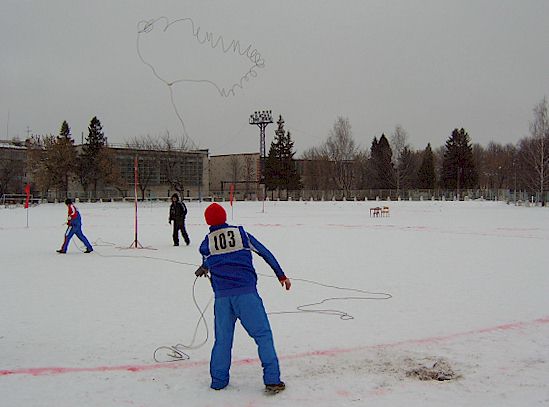
The throwing tinzayna on a pole is carried out on play-ground. For this purpose the pole is established in the center of a platform vertical. The throwing is made from any point of a circle (R - a circle it is equal 15 meters), the height of a pole is equal to 3 meters (fig. 1).

At performance of a throwing tinzayna on a pole exist a little rule of competitions:
the participant has the right to three attempts (each of three attempts of a throwing proceeds up to the first miss);
in test there is the best result from 3 attempts;
the participant should have the acts with the tinzayn;
the participant leaves on a line of a throw on a call of the judge "on start" and throw on a command it "is possible";
on performance of one throw it is given two minutes (readout time is made from the moment of a command of the judge it "is possible");
each participant has on assembly tinzayn only 3 minutes;
the participant collects tinzayn without the help of the stranger;
It is authorized to help the participant only at stretching tinzayn;
the result of a throw is set off, if the participant in limit rules has made a throw, has not taken up a line of a circle and a pole appeared covered tinzayn (inside a loop); thus the judge declares "is" and lifts a tag upwards;
the participant is authorized to enter into a circle only on permission judges;
the throw tinzayn is not set off, if after a command it "is possible" the sportsman has not made a throw (deliberately or owing to unavailability), the participant has taken up, cross a line of a circle, at a throw the end tinzayn has not remained in a hand of the participant, the loop tinzayn has fallen by a pole, the throw has been made without a command of the judge on a line of a circle;
the participant has the right to make replacement tinzayn only from the sanction of the judge to lines of a circle.
Run with a stick on a cross-country terrainIn sports practice for cross-country run participants use a stick (which length is supposed up to 130 cm, diameter not less than 10 mm, weight - any). The stick can to be metal, duralumin, wooden or from other material. Sportsmen are forbidden to apply for track and field athletics shoes with thorns.
Competitions are carried out for adults on a distance of 3000 m, for youthies 2000 m, for young men on 1000 m. The distance competitions on running with a stick on a cross-country terrain are laid on wood footpaths, earth roads, in tundra.
On separate sites should be natural barrier as, streamlets, holes, rises, descents, etc. at which overcoming the sportsman could use a stick.
Performance of this exercise is difficult and demands from the sportsman of good technique of run on various districts, skilful overcoming of meeting obstacles, high train and the big will in achievement the best result. By rules of competitions, a distance can to lay on the closed route with start and finish in one place, and also on usual a route. But in opposite a case start and finish settle down in different places that causes the certain difficulties in work of a judiciary board.
Start by rules of competitions moves on one, pair, group. But more often at competitions of a various level, single start practices.
Participants according to a toss-up will start one by one in 30 seconds, thus the sportsman is authorized to hold a stick in any hand. For 5 seconds the judge - starter puts a hand on a shoulder or on a forearm of the participant and counts the staying seconds (5, 4, 3, 2, 1 "march") and simultaneously cleans(removes) a hand.
At group start moves two commands: "on start" and "march".
According to rules of competitions run with a stick on cross-country districts is carried out by the second kind under the account after a throwing tinzayn on a pole.
Throwing of an sports axe on rangeSports axe throwing in a corridor which width is equal 60 m, and also the sector is necessary for start, which length should be not less 20 meters (fig. 11).
According to rules of competitions, it is necessary to execute the following requirements: in competitions the axe has weight not less than 350 gr. is used; in one hour prior to the beginning of competitions an axe weigh and mark; it is not authorized throwing an axe which is not having marks of the given competition; the participant of competitions is authorized to enter into sector for throwing only on a call of the judge; it is authorized to make a throwing of an axe on the command of the judge submitted by sharp lowering red flag of a tag and a voice it "is possible"; the participant is authorized to execute 3 attempts; in offset there is the best result; on performance attempts 3 minutes are given; if in sector for a throwing the participant has not left on a call of the judge on performance of attempt in distance screw sheer "absence" is put down.
Attempt is set off: If the participant at a throwing of an axe has not made a spade on a line of a throw and the shell has landed in a corridor of sector.
Attempt is not set off: If a throwing of an axe It is executed without a command of the judge if the spade on a line of a throw is made, the shell has landed behind a corridor of sector.
Sports axe shell - in weight not less than 350. Sports axe will consist of two parts: handles (a) and a metal part (b) an edge and a butt (fig. 12).
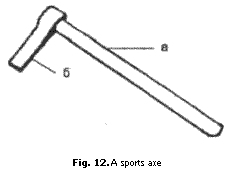
The length of an edge makes 200-230 mm, width of an edge of 25-30 mm, width of a butt of 25-30 mm, length of a butt of 45-55 mm, thickness of 2,5-3 mm. Length of the handle of 550-650 mm, width of 40-50 mm. Thickness at edges(territories) of the handle makes 0,5-0,8 mm, in an average part of 10-12 mm. The handle of an axe is made usually from birch or cedar wood.

The techniques of a throwing of a sports axe includes start with assignment of a shell, a throw (final effort) and braking before a line of a throw (fig. 13). The anthropometrical data influence length of a working way of a shell and are within the limits of 160-220 see. The throwing of an axe on range is carried out from direct start. On fig. 15 consecutive positions of the thrower, since last step of start till the moment of release of an axe from hands are shown.
The techniques of a throwing of an axe has much in common with techniques throwing spears and pomegranates.
The techniques of a throwing of an axe has also the features. The most typical is the way described by an axe during time of swing and the throw. This element of techniques is the main part, and its feature consists in that an axe during its release from a hand to give rotary movement in a combination with sharp enough a throw, with giving to it of the specified rotary movement. Rotation of an axe turns in a flat lateral surface of an edge of the axe, having The certain a corner of an inclination to a surface of the ground. The plane rotation an axe is a tangent to its trajectory (at the moment of release from hands the corner between a surface of the ground and a plane of rotation of an axe is equal to a corner of its start).
Range of flight of an axe is defined correct it release. At competitions some sportsmen throwing a sports axe for 200 m. Such high results, in our opinion, speak aerodynamic properties of an axe. At release the axe receives rotation counter-clockwise. If to consider flight of an axe in air, its form such, that at influence on it of the air environment there are aerodynamic forces: frontal resistance and elevating force.
Having combined the forces working in flight on a shell, we to receive their equally effective or, so-called, aerodynamic force. Rotation of an axe in own plane having an optimum corner of an inclination to a surface of the ground, leads to the least resistance of air and promotes the elevating force causing longer flight of an axe.
The handle of an axe should be made with the account physical standard of the sportsman. In a throwing sports axe speed is informed in progress with addition of speed in axe rotary movement. At each sportsman there should be an optimum active way of influence on axe, which is that greatest way at which the thrower manages to create the maximal force of influence.
Threefold national jump (with simultaneous pushing away by two foots)Competitions on a threefold national jump (with simultaneous pushing away by two foots) are carried out by the following rules: the participant has the right to 3 attempts. In offset there is the best result which is defined by measurement of the shortest distance from things in common by any part of a body with the ground (floor) before initial pushing away. It is necessary for the participant on a call of the judge and a command it "is possible", a rising of a tag upwards, to execute attempt of a jump. The result is not set off, the judge declares "is not present" and makes repeated wave below or lifts a white tag:
if the participant has executed jumps without a command of the judge it "is possible";
pushing away in jumps is made by one foot;
in an initial jump has made a spade;
after the termination of performance of jumps the sportsman has left sector back (the exit is made only before, has come on a line of a corridor).
Jumps with simultaneous pushing away by two foot concern to cyclic exercises. The cycle will consist of start, the pushing away, three consecutive jumps and a landing. In jumps the sportsmen possessing high-speed qualities in sprint, possessing far jumps and rational techniques achieve the best results.
At present start is carried out from 10 and more meters and depends on qualification of the sportsman and conditions of carrying out of competitions. Pushing away in jumps is made by two foots.
On a place of pushing away both foots are put on all foot, socks should be at one level, plant a foot of foots on distance of length stops it is not authorized. At the moment of pushing away the jumper slightly bends foots.
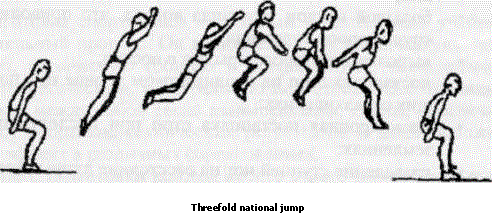
His trunk is inclined forward, hands are allocated back up. Pushing away begins with straightening foots and sharp movement of hands forward upwards, and comes to an end full straightening of foots. In a phase of flight of a foot are bent in knee joints, the trunk is inclined forward.
The landing in the subsequent jumps is made on a full foot. It is necessary to achieve good preservation of balance in flight phases.
Range of a threefold national jump will increase from horizontal speed of start, elastic and powerful amortization in basic phases. The cycle comes to an end on the third jump ejection foots forward.
Typical mistakes at performance of a jump are the following:
statement stop at a unequal level at jump pushing away from a support;
the big inclination of a trunk forward, that leads to "twisting" of a trunk;
performance of the second jump from socks;
statement stop at a unequal level at the following jumps ;
no synchronous statement stop at the subsequent landings;
cultivation by a foot on distance of length stops.
Jumps through narti (sledge-breadboard models)Jumps through narti are made by the following rules:
jumps are carried out with simultaneous pushing away two foots from a place; narti are placed strictly as the crow flies, them place it is marked by lime or others, not creating To the participant of a handicap that it was visible, are shifted narti whether or not;
narti should be numbered;
each participant has the right to three attempts, in offset. There is the best result from three attempts;
participants carry out jumps serially, agrees record in the report (the sequence is established of casting); on one attempt all participants carry out, and then in the same order start the second attempt, etc.;
the participant leaves on an initial position on a call of the judge and starts to carry out jumps only from the sanction of the judge;
it is authorized to make carry of foots through narti only directly before itself;
the participant who has overcome 10 narti, does makes by a jump turn a mouth on 180°, pushing away two foots is necessary with simultaneous;
on turn 5 seconds (readout of time is made from the moment of a landing after overcoming by last narti till the moment of pushing away for jump through ) are given;
jumps through narti are carried out by participants up to first mistakes;
before the beginning of jumps up to a command of the judge it "is possible" the participant has the right to move, cross foots, to jump up on a place.
to jump follows in sports to footwear, except for the Czech gymnastic slippers. To jump barefoot it is authorized.
The judge stops jumps in that case, when:
during overcoming narti the sportsman has stopped off Between them, i.e. has got off from a rhythm of jumps;
has broken a rule of 5 seconds on turn;
has shifted narti from a place any part of a body;
has made cross or movement stop;
has made carry of lfoots;
through narti their cultivation in right or the left party;
has touched hands or any part of a body belts(zones) are higher;
has independently stopped jumps.
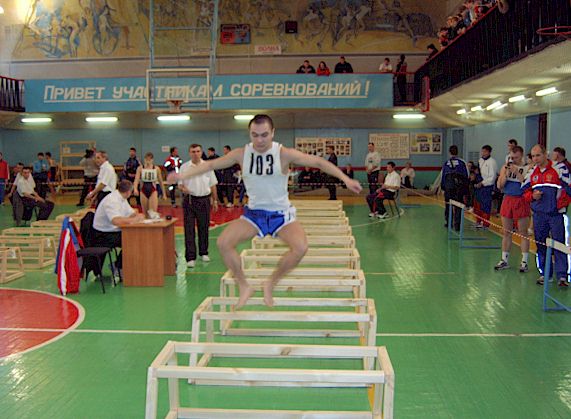
Prominent features of the given kind of sports are jumps with pushing away simultaneously two foots from a place through an obstacle - narti. According to rules of competitions, it is necessary for sportsman to overcome ten narti, placed in one number (line).
In sports practice breadboard models narti are applied. Breadboard models narti make from wooden bars 5-6 see. The sizes narti have the following parameters: height - 50 cm, width at the top of-50 cm, width at the basis - 70 cm, length - 150 - 200 see.
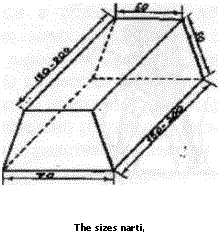
For sportsmen till 14 years the sizes narti the following: height - 40 cm, width above - 40 cm, width at the basis - 60 cm, length of 100 sm.
At the analysis of techniques in jumps through narti it is necessary to allocate the basic making phases: pushing away, flight and a landing.

Pushing away is carried out from two foots simultaneously, with all stops with accent (stress) on their external vaults. Pushing away you as a result of interaction of all parts of a body of jumper. When occurs sharp to unbend in knee, talocrural and femora joints, and also hands.
After pushing away both foots are tightened to a breast, hands after pushing away fall a little, straightened and support balance. The sportsman gets necessary height of flight which makes 55-60 see.
Simultaneously foots start to be unbent due to lowering a hip and movement of a shin on inertia forward. A landing happens on a forward part stop. Thus heels stop are reduced together, socks are developed outside. Hands, continuing the started movement, fall forward - back. It compensating movement promotes preservation of stability.
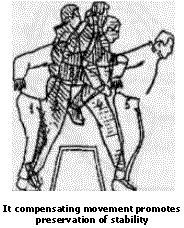
According to rules of competitions, the participant who has overcome 10 narti, does makes turn on 180°.
Turn is carried out by a jump with simultaneous push off foots. Time of 5 seconds (readout of time is made from the moment of a landing after get over last narti till the moment of pushing away for get over the subsequent series of jumps) is given the participant.
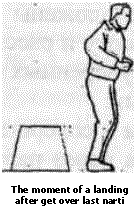
The conducted investigations make possible for us to glimpse into the near future (to 40-50 years) in order to consider the influence of different factors on the development of the northern regions of Russia, and at the same time to the formation of the cultural heritage of peoples. In the present period occurs gradual urbanization, and together with this and the assimilation of the radical peoples of Siberia with the Russian nation, the loss of national culture and mastery by petroleum, gas and chemical industry newer and newer territories.
It is necessary to manufacture the general trend in retention and development of national physical culture, which will make it possible to avoid the errors of the past. Over the long term in connection with the impoverishment of hydrocarbons and the appearance of alternative energy sources northern territories declare by the zones of the natural preserves, in which they will live indigenous peoples. Will be artificially here developed ecological trade and reindeer breeding, necessary for the vital activity of peoples, and also local trades: the preparation of the skins of deer, the production of souvenirs, different national clothing. Through the regions will pass tourist routes, and also 3kstrim- tourism, bearing profit to local residents. Will change the appearance of the inhabitants of the north, who are presented to us by the educated people, which manage the Internet and the equipped cell phones.
In the new economic conditions traditional physical exercises serve as the means of the association of the natives of different regions, and also formation and training. Is possible to assume that not will be forgotten the races on the deer and canine harnesses, races on top of deer, horse sport, the throwing of lasso on choreas, the leaps through the sledges, shooting from bow, throwing of axe, run with the staff, pulling of stick and so forth is completely possible and the modification: race on the "snow-storms", automobile rally (with the special wheels on the impenetrable taiga places, the tundra). In the international arena the national forms of the sport of the radical peoples of Siberia will be included in spartakiadas and festivals, which will pass as the forums of peoples with the use of health-improvement, educational and educational functions of national physical exercises.
Traditional games and contests must become the connecting link between the culture of the past, present and future of the natives of Siberian region.
References
Krasilnikov V. (2002) Games and competitions in traditional physical education of Khanti. Ekaterinburg,. P.120.
Krasilnikov V. (1994) and others. Games of Khanti // Physical culture at school. Moscow
Krasilnikov V. (2003) The problems of specialist training in physical culture and sport for Ural-Siberian region // Perfection of cadre preparation in physical culture and sport in condition of modernization of vocational education in Russia: Conference thesis. Moscow, March, 13-14. 2003. 234 p.
Krasilnikov V. (1993) The role of traditional games in physical education of the Khanti's rising generation // Problems of physical education in schools of Sakhalin region. Thesis report of science-practical conference. Khabarovsk, April, 18-20, 1993.
Krasilnikov V. (1993) Traditional means of Khanti's physical education // The Seventh Vinogradov's readings: Thesis report of science-practical conference, Ekaterinburg, June, 14-17 1993
Krasilnikov V. (1998) Folklore and national traditions in physical education of Siberian children // Place and meaning of folklore and folklorism in national cultures: history and the present. Chelyabinsk
Krasilnikov V. (1995) Ethnopedagogy's conditions of using of Khanti games and competitions // Theory and history of games. Moscow.
Krasilnikov V. (1994) Ethnopedagogy's conditions of using of Khanti games in traditional physical education. Abstract of Dissertation of candidate of pedagogical sciences / Ural State Pedagogical University. Ekaterinburg, 18 p.
 |
|
|---|---|
|
revista
digital · Año 11 · N° 106 | Buenos Aires,
Marzo 2007 |
|
 At present traditional games and competitions were transformed to a new kind of sports "Northern multiathlon". By federal agency on physical training, sports and tourism of the Russian Federation, Federation of northern multiathlon (chairman - A.V.Nazarov, general director O.V.Dolumadzhanova) from November, 21 till November, 25, 2006 have been organized and lead to Zavolzhie, the Nizhniy Novgorod area the Championship and Superiority of Russia by this kind of sports.
At present traditional games and competitions were transformed to a new kind of sports "Northern multiathlon". By federal agency on physical training, sports and tourism of the Russian Federation, Federation of northern multiathlon (chairman - A.V.Nazarov, general director O.V.Dolumadzhanova) from November, 21 till November, 25, 2006 have been organized and lead to Zavolzhie, the Nizhniy Novgorod area the Championship and Superiority of Russia by this kind of sports.